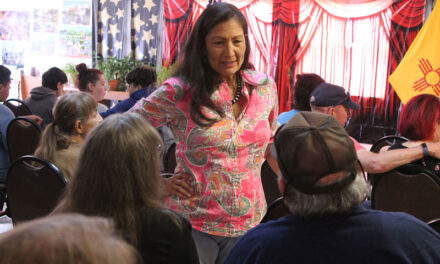Socorro
For some Rio Grande Valley farmers, the newly proposed Rio Grande silvery minnow critical habitat symbolizes an end to their livelihood and history.
But, to others, such as the U.S. Fish and Wildlife Service, designating the Middle Rio Grande, extending from the Cochiti Reservoir to Elephant Butte, as well as a 300-foot riparian area on both sides of the river, is necessary to preserve a habitat they believe is dying.
Locals and other governmental officials were given the opportunity to voice their concerns last week at a public hearing in Macey Center in Socorro, in front of a panel consisting of FWS biologists and the orator, former attorney Lotario Ortega.
Before the floor was opened up to the public, the biologists briefly explained the newly-drafted biological and economic impact statements. They also explained the reasoning behind their conclusions.
According to the FWS, the 300-foot riparian area will exclude certain portions along the river.
“Lands located within the exterior boundaries of the proposed critical habitat designation, but not considered critical habitat are excluded by definition, include: existing paved roads, bridges, parking lots, dikes, levees, diversion structures, railroad tracks, railroad trestles, water diversion canals outside of natural stream channels, active gravel pits, cultivated agricultural land, and residential, industrial and developments,” the FWS reported.
The FWS also believes the water target flows needed to support the critical habitat area will not be adversely affected by the new ruling. “The target flows in the Rio Grande that we have recommended in the past will not differ,” H. Dale Hall, director of FWS’s southwest region, said in an earlier press release. “We anticipate that this proposal will have little impact on water users.”
However, local farmers and landowners disagree, saying current silvery minnow policy is negatively affecting water supply to their fields, which is causing a significant reduction in alfalfa hay production — the biggest crop in the area.
“It’s taken 25 to 30 days for everyone to get their watering done. I have waited up to 40 days,” Lae Hale, a farmer and rancher from Lemitar, said, at a gathering at his home before the meeting.
Hale said farmers need to irrigate their fields every 15 days to yield a normal alfalfa crop at a cutting every 30 days, however, because they’re currently under a rotation, they are unable to do so.
Don Davenport, another area farmer, also spoke at the gathering and said he has seen a 20 to 30 percent decrease in plant size per cutting. He said, if the situation continues, farmers will have no choice but to raise their selling prices, which will eventually affect the consumer.
Hale said there is currently water in the river, but farmers cannot use it, as it is being used for the silvery minnow.
Davenport agreed but added that another two reasons for the water shortage is farmers in Belen illegally obtaining water and the Pueblos, which don’t have any regulations placed on their water usage.
“You add these three things together and it is a brutal situation,” he said.
The FWS maintains that the economic impact will be minimal, if non-existent, to area farmers and ranchers. “We anticipate that this proposal will have little impact on water users,” Hale said.
Despite such assurances, many landowners feel the FWS is offering false information about the critical habitat area, as well as the economic impact statement, and believe the new designation will end most farming in the valley.
Socorro Mayor Ravi Bhasker said the numbers from the economic impact statement are arbitrary and “not realistic.” He also said he takes argument with the fact that the FWS didn’t send information regarding the hearing on time or talk to any local citizens about it.
Socorro County farmer Larry Whitefield, who is also vice-chairman of the Socorro SWCD board of supervisors, said the biological study is also arbitrary, because, unlike science, which has a clear hypothesis proven by solid data and a solid conclusion, the impact statement does not.
“Before you implement your ideas, make sure they’re correct,” he said.
Others blame the FWS, saying it has not investigated enough areas and ignored certain aspects of the Rio Grande that are also critical to determining water flow. Nyleen Stowe, program manager for the Socorro SWCD, said the FWS didn’t include watershed management in its study.
Stowe said juniper, and especially salt cedar trees, have infested a large portion of the Rio Grande and its tributaries. She said a mature salt cedar could consume up to 200 gallons of water per day.
Stowe also said there is poor communications among different governmental agencies, such as the City of Albuquerque and the FWS. The City of Albuquerque is planning to divert up to 103,000 acre-feet of water from San Juan Chama, despite the fact it only has rights to 47,000 acre-feet of the water, she said.
Stowe said Albuquerque plans to make up the difference through water it releases from its wastewater plant, which will be full of chemicals such as estrogen compounds — compounds the EPA doesn’t test for. She said these compounds alone pose a serious threat to the minnow.
“I cannot emphasize strongly enough the need for the U.S. Fish and Wildlife Service to review this environmental impact study and work with the City of Albuquerque to find a reasonable solution to maintain silvery minnow habitat through Albuquerque and to not just immediately blame the agricultural community of Socorro,” she said.
Hall said the silvery minnow has a good recovery potential. “We will continue to work closely with area landowners and water users as we refine this proposal and develop strategies to meet the needs of the minnow and the surrounding communities,” he said.
Joy Nicholopoulos, field supervisor at the New Mexico Ecological Services Field Office for the FWS, said: “Public comments will be analyzed. The proposal will be modified, but not expanded,” she said.
According to the FWS, “a critical habitat is defined as a specific geographic area that is essential for the conservation of a threatened or endangered species that may require special management and protection. Critical habitat may include an area that is not currently occupied by the species, but will be needed for its recovery.”
















